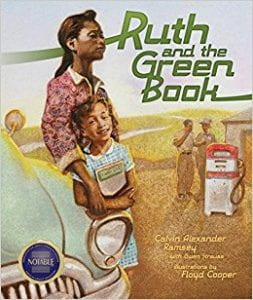 Ruth was so excited to take a trip in the new family car! But she soon found out that black travelers weren’t treated well in some towns. Many hotels and gas stations refused service to black people. Finally, a friendly gas station attendant gave Ruth’s family The Green Book. This book listed all the places that would welcome black travelers. With this guidebook, Ruth’s family could finally make a safe journey from Chicago to Alabama to see her grandma.
Ruth was so excited to take a trip in the new family car! But she soon found out that black travelers weren’t treated well in some towns. Many hotels and gas stations refused service to black people. Finally, a friendly gas station attendant gave Ruth’s family The Green Book. This book listed all the places that would welcome black travelers. With this guidebook, Ruth’s family could finally make a safe journey from Chicago to Alabama to see her grandma.
The Green Book and its role in helping a generation of black travelers avoid some of the indignities of Jim Crow are historical fact.
As an award-winning Atlanta book author and playwright, Calvin Alexander Ramsey concentrates on what he calls “unknown pages in African American history”. In fact, Ramsey’s first work, titles The Green Book, is based on the guidebook discussed in Ruth and the Green Book, and performed in 2007. In his play, Ramsey sought to recapture interviews with scores of African Americans whom recalled emotions of peril and fear while traveling. The play sold out many performances and won recognition as a finalist in the 12th Annual Last Frontier Conference. Visit calvinalexdanderramseysr.com for more information and other work completed by the author.
About The Author
 Calvin Alexander Ramsey is a man of numerous talents. Not only does he write award winning picture books for children, he is a photographer, a folk art painter, and a playwright. His plays have won awards as they traveled across the country to Washington, D.C., Atlanta; Omaha, Nebraska; San Francisco; and Alaska. That schedule surely agrees with Calvin because he has called many cities home: Martha’s Vineyard; New York City; Santa Monica, California; Chapel Hill, North Carolina; and the U.S. Virgin Islands of St. Croix and St. John. Now he lives in Atlanta, Georgia.
Calvin Alexander Ramsey is a man of numerous talents. Not only does he write award winning picture books for children, he is a photographer, a folk art painter, and a playwright. His plays have won awards as they traveled across the country to Washington, D.C., Atlanta; Omaha, Nebraska; San Francisco; and Alaska. That schedule surely agrees with Calvin because he has called many cities home: Martha’s Vineyard; New York City; Santa Monica, California; Chapel Hill, North Carolina; and the U.S. Virgin Islands of St. Croix and St. John. Now he lives in Atlanta, Georgia.
Read Aloud Tips
-
- Introduce the book, author and illustrations.
- Use a map to show students the distance between Chicago and Alabama. Discuss what people may need for a long trip.
- Give examples of how different life might be for black Americans during the 1950s.
- Think about ways that issues could be debated as a class (use the debate centers).
“Cooper masterfully captures the emotions of the characters, filling his pages with three-dimensional individuals. This story touches on a little-known moment in American history with elegance, compassion and humanity.” – Kirkus Reviews